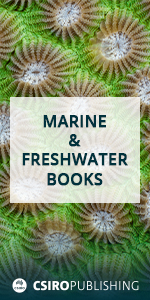Marine and Freshwater Research
Volume 65
Number 8 2014
Environmental or instream flows are the main management technique used to ameliorate the ecological effects of flow alteration. We highlight the concept of transparent and translucent flows, rules not commonly used in a managed flow regimes. These flow rules help return natural flow variability and we identify their benefits, provide a review of their historical application and demonstrate their implementation in two case studies in Australia.
Validated age and growth estimates are crucial to fisheries management, but are still uncommon for elasmobranch species. Bomb radiocarbon analysis was used to validate lifespan of sand tiger shark (Carcharias taurus) and indicated that ages based on vertebral growth-band counts were underestimated by up to 18 years in the largest specimens. These results have implications for management of C. taurus populations and also suggest that measurable vertebral growth may cease at some point.
The present study provides a quantitative and qualitative analysis of the dentition of Mustelus schmitti, and estimates the tooth-replacement rate following established methods used for fossil sharks (instead of the established technique of clipping teeth) based on the premise that tooth length within each row decreases from the lingual to the labial side of the jaw as a consequence of wear. M. schmitti exhibited homodont dentition, the dental formula was elucidated, and the estimated mean replacement rate was 4 days series–1.
The study of metabolic states in a tropical sea is a valuable contribution to the understanding of coastal carbon cycle. We determine seasonal exports of river nutrients and organic carbon and their influences on coastal metabolic states. This tropical sea is autotrophic in summer and largely heterotrophic in winter having a linkage to sink and source of atmospheric CO2, respectively.
Global declines in riverine fish numbers are inherently linked to habitat fragmentation and unnatural reductions in water temperature, restricting upstream movements essential to survival. Swimming ability of small fish was assessed, finding performance to be markedly reduced by rapid reductions in water temperature. The effect of water velocity and temperature on swimming ability were modelled, with an emphasis on facilitating upstream passage for the entire fish community, large and small.
Secondary carbonate production is an important, yet poorly understood, component of reef calcification. The present study aims to generate the first estimates of encruster carbonate production for the central Indian Ocean and shows that encruster communities are capable of contributing high rates of calcium carbonate (up to 0.112 g cm–2 year–1) to clear-water reef environments. Carbonate production at the organism level has direct implications for the ecological functioning and geomorphic development of reefs, particularly as global coral cover continues to decline.
A pioneering study of the fourth largest hydrographic river basin in the world showed diversity patterns of freshwater copepods and highlighted the importance of variables such as turbidity and water flow. La Plata Basin in South America is also highly affected by human activities such as reservoir construction and pollution. Total copepod species richness was half of the estimated gamma diversity; it increased according to the size of the river, but decreased with high turbidity, high water velocity and extreme water-retention time (in reservoirs).
Black swans are an iconic waterbird in Australia though little is known about their grazing ecology. This study quantified black swan abundance in the Swan River Estuary (WA) and the pressure they exert on seagrasses, showing that they consume 6–25% of the seagrass production across all seasons of the year. This demonstrates that swans are an important part of estuarine foodwebs and a significant stress on important seagrass habitat, which may be exacerbated by human-induced impacts.
The effects of sewage pollution on invertebrate communities from rocky shores were studied, taking into account the changes in biomass and secondary production among dominant species and feeding guilds. An increase in the community production was observed near the sewage-affected areas, mostly due to tolerant and contaminated species and suspension feeders. Secondary production was important for understanding anthropogenic impacts in the functioning of the ecosystem.




